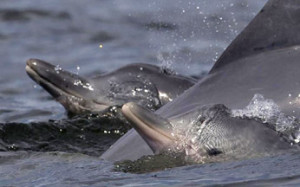When the orca Morgan beached herself in Tenerife, the Internet exploded with speculation and criticism of captivity.A captive killer whale in a marine park was recently filmed after a show appearing to beach herself on a concrete ledge. Some call her actions “suicidal,” speculating that she was trying to end her life because she was suffering in a life of captivity. While the behavior is startling, experts say it’s highly unlikely she jumped up on the ledge because she was trying to kill herself. Instead, it was more likely that she was trying to escape other orcas, who were bullying her in the tank. “She’s coming out to avoid antagonistic behavior from other orcas,” says Ingrid Visser, a marine biologist with the Orca Research Trust in New Zealand. The short viral video of Morgan the orca, shot at Loro Parque in Tenerife, Spain, shows Morgan on a concrete ledge by the side of the pool.
It was shot anonymously on May 16 and posted on the Dolphin Project, a nonprofit dedicated to ending dolphin exploitation. Orcas belong to the dolphin family. Morgan is owned by SeaWorld and is used in shows to entertain the public in Tenerife. She was rescued in the Netherlands at a young age and SeaWorld says she can’t be released to the wild because she is deaf and doesn’t have the skills to survive in the wild.On Wednesday, a longer video was released showing that Morgan stayed out of the pool for nine minutes, after a trainer signaled to her to return to the water. However, 42 seconds later, she gets on the ledge again. Witnesses describe her being body-slammed by the other orcas in the pool, who were allegedly not evaluated for social compatibility before being put in the tank together. (Read about Tilikum, SeaWorld’s most controversial orca.) Jeffrey Ventre, a former SeaWorld trainer-turned anti-orca-captivity activist, and star of the anti-Seaworld film Blackfish, considers Morgan’s actions typical “escape behavior.”
“She was inserted into this social group with five other whales that she doesn’t get along with,” Ventre said in an interview with Sky News. “It looks like she jumped up on that stage area to get away from the other whales…I think that that was a way for her to prevent from getting beat up further.” (Hear from another former trainer.)The press release from Loro Parque states that the whales are trained to jump onto the ledge for various reasons like check-ups, and sometimes for fun they spontaneously do the jumps they were trained to do. “To speculate that this [behavior by Morgan] represents a sign of stress demonstrates utter ignorance about the natural behavior of this species,” their blog post states.
However, Visser says that the behavior was anything but normal. In the wild, orcas have never been observed beaching themselves intentionally for long periods of time, only sometimes for a moment while hunting in shallow water.
“They phrase these things so that they’re like fairy tales, but they’re really nightmares,” she says.




